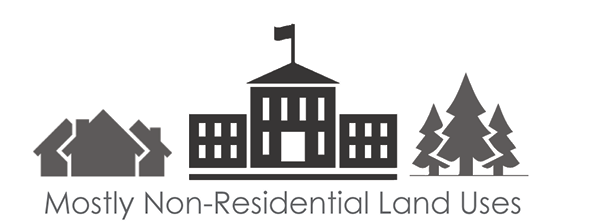Home / B. Place Types Manual / Place Types: Commercial
Manuals and Metrics
Table of contents
Place Types: Commercial

Goal: Provide places for the sale of goods and services in locations readily accessible by automobile.
Commercial places are primarily car-oriented destinations for retail, services, hospitality, and dining, often along major streets or near interstates.

- Typical uses include shopping centers, standalone retail uses, personal services, hotels, restaurants, and service stations.
- This Place Type is characterized by low-rise retail structures with a walkable, landscaped public realm that balances automobile, bicycle, and pedestrian design elements.
- Commercial places are typically located along high-volume arterial streets, limited access roadways, and near interstate interchanges.
- While uses and sites are generally automobile-oriented, streets are designed to accommodate safe and comfortable travel by all modes of travel.
- Cross-access between adjoining sites limits the number of driveways off arterial streets, thereby improving the public realm and circulation.
- Arterial streets support walking, cycling, and transit use by providing a safe and comfortable environment to reach transit stops, jobs, or nearby destinations.
- The typical building height is four or fewer stories. If located in an interchange area, buildings may be up to 5 stories.
- Long, continuous buildings, especially strip commercial buildings, can be found in Commercial places. These buildings still accommodate the desired block structure and connected street network.
- Some sites include accessory drive through facilities and gas pumps.
- Buildings include entrances on the street-facing side(s) to provide pedestrian access from the public sidewalk.
- This Place Type includes numerous improved open spaces such as plazas, patios, and courtyards that may include landscaping.
- Natural open spaces, such as tree preservation areas, are also found and encouraged here.
- Landscaping provides an attractive public realm by softening street edges.
Place Type graphics are conceptual and for illustrative purposes only
- Consolidated driveways and access points
- Frequent pedestrian connections to and between buildings and blocks
- 1-3 story infill buildings oriented towards the street with commercial, office, hospitality, and mixed-use
- On street and surface parking (located to the side and behind buildings as feasible)
- Increase in housing density near commercial activity
- Buildings forms, sizes, and styles vary based on use, but typically buildings are placed along the street whenever feasible.
- Windows, doors, and clear public entries are located along the street frontage with parking or services on the side or in the rear.
- Wider planting strips, sidewalks and bike lanes along larger streets separate pedestrians and higher speed vehicles and provide a more comfortable pedestrian environment.
- While discouraged, limited parking and drive-through lanes may be located between the sidewalk and the front door.
- Outdoor dining areas along the sidewalk and street provide a more vibrant public realm.
- Pedestrian connections are provided from the street and sidewalk directly to the front door of commercial buildings.
- Developments with multiple retail tenants and clear pedestrian connections create a safe, walkable environment.
- Tree canopy is made up of primarily street trees, trees in parking lot islands and along pedestrian paths. Where structured parking exists, trees are more integrated into courtyards, plazas and common areas.
- Newly constructed streets and sidewalks support the growth and longevity of large stature trees.
- In on-street and off-street parking areas, there is sufficient tree canopy cover to provide shade and more pleasant pedestrian experience.
- Tree canopy cover ranges from 25% – 35%.
- Transitions use site-based elements such as parking, open space, and landscape buffers to create separation from less intense Place Types.
- Buildings are typically located away from the street at a distance that still allows for safe and comfortable pedestrian connections from the public sidewalk.
- Some buildings, especially buildings on smaller parcels, may be located closer to the street.
- Buildings may be located near the side and rear property lines but are frequently separated from these edges. When abutting neighborhoods, the buildings are further from the property line and there is room for a landscaped buffer.
- Parking is typically provided on surface lots. While not discouraged, structured parking is usually not found in this Place Type.
- Surface parking is usually located to the side or rear of buildings. Surface parking in front of buildings is allowed, but the size should be limited.
- Parking lots in front of buildings provide a clear pedestrian path between the public sidewalk and building entrances.
- Loading and service areas are located to the rear of buildings and screened from streets.
- Parking areas and areas adjacent to buildings and destinations include accommodations for rideshare access, micro mobility options, and designated bike and scooter parking.
- Commercial places are typically located along major arterial streets, and the street network has excellent internal and external connectivity.
- The network connects to and enhances the adjoining network to provide for route and mode choice and is dense enough to provide direct and efficient access from sites to arterials.
- The preferred block length is 600 feet and block lengths typically do not exceed 650 feet. The preferred block lengths provide the connectivity needed to support multiple route options within and to the Commercial places, surrounding destinations, and arterial streets, thereby encouraging the use of other modes of transportation and helping to disperse vehicular traffic.
- Standard 6-foot sidewalks with planting strips on local, collector, and arterial streets are sufficient in most locations.
- Sites include clear and visible pedestrian access between the streets and the buildings.
- Separated bike lanes are provided on Arterial streets, sharrows are included on some Local streets. The bike network is complete, well-marked, safe, and easy to use.
- Shared use paths are provided where they are shown on the adopted Streets Map, and also between the street and buildings to connect the pedestrian and bicycle network to entries.
- Commercial places have primarily vehicular access.
- Commercial sites are primarily accessed from arterial or collector streets, but local streets are also utilized and are designed to provide safe connections from adjacent neighborhoods and places, to better accommodate all transportation modes.
- Commercial places have a limited number of driveways off arterial streets and cross access is necessary between adjacent sites.
- Alleys are also used to provide cross access between sites.
- On-street parking is found along local and collector streets adjacent to or within the internal network of Commercial places.
- Arterial streets are designed to accommodate higher traffic volumes and do not typically have on-street parking.
- The curb space along local and collector streets has moderate turnover and therefore requires a moderate amount of curb management to accommodate multiple users.
- There are limited opportunities for Transportation Demand Management.



